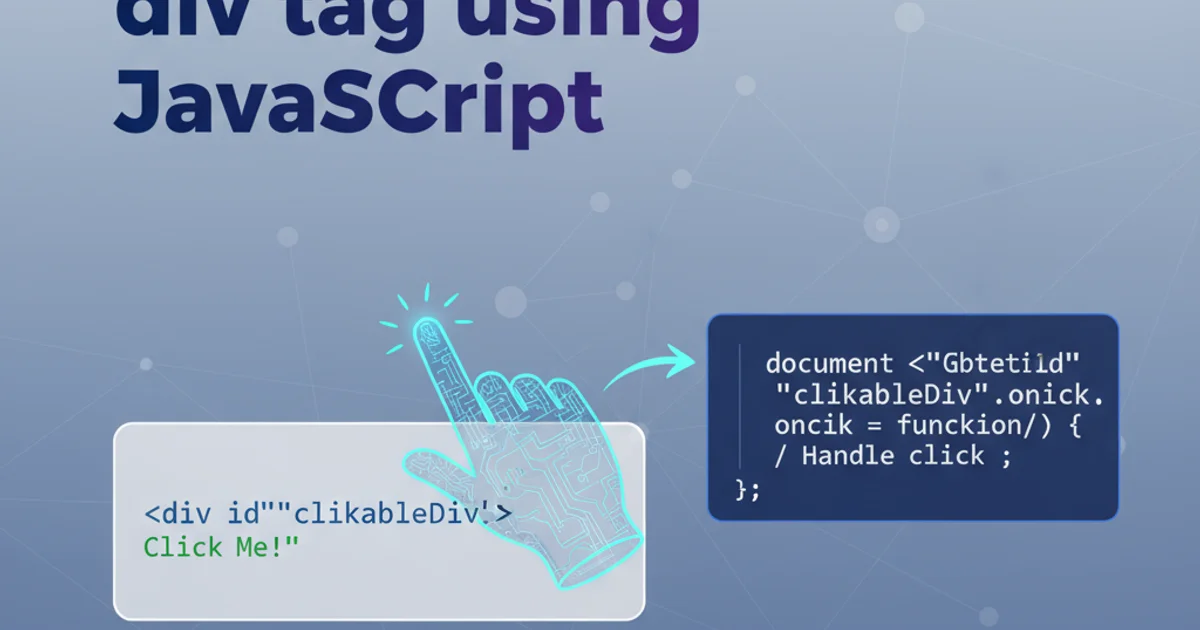Add click event on div tag using JavaScript
Categories:
Adding Click Events to Div Tags with JavaScript

Learn how to effectively attach and manage click events on <div> elements using various JavaScript techniques, from inline handlers to event delegation.
Interactivity is a cornerstone of modern web development, and responding to user actions like clicks is fundamental. The <div> element, a versatile container, often serves as a target for such interactions. This article explores different methods to add click event listeners to <div> tags using JavaScript, covering basic approaches, best practices, and advanced techniques like event delegation.
Basic Event Handling: onclick Attribute
The simplest way to add a click event is by using the onclick HTML attribute directly on the <div> tag. While straightforward for very simple cases, this method mixes HTML and JavaScript, which can make code harder to maintain and debug for complex applications. It's generally discouraged for larger projects but useful for quick prototypes or understanding the basic concept.
<div id="myDiv" onclick="alert('Div clicked!');">
Click me!
</div>
Using the onclick attribute directly in HTML.
Modern Event Handling: addEventListener
The addEventListener() method is the preferred way to attach event handlers in JavaScript. It offers several advantages over the onclick attribute:
- Separation of Concerns: Keeps JavaScript logic separate from HTML structure.
- Multiple Handlers: Allows multiple event handlers for the same event on the same element.
- Event Phases: Provides control over event bubbling and capturing phases.
This method is robust and flexible, making it suitable for most web development scenarios.
<div id="myModernDiv">
Click me (modern way)!
</div>
HTML structure for addEventListener example.
document.addEventListener('DOMContentLoaded', () => {
const myDiv = document.getElementById('myModernDiv');
if (myDiv) {
myDiv.addEventListener('click', () => {
alert('Modern Div clicked!');
});
}
});
Attaching a click event using addEventListener.
DOMContentLoaded listener or place it at the end of the <body> tag. This ensures the HTML elements are fully loaded before your script tries to access them.Advanced Technique: Event Delegation
Event delegation is a powerful pattern for handling events on multiple child elements efficiently. Instead of attaching an event listener to each individual <div>, you attach a single listener to a common parent element. When an event bubbles up to the parent, you can then determine which child element was the original target and respond accordingly.
This approach is particularly useful for:
- Dynamically added elements (elements created after the page loads).
- Improving performance by reducing the number of event listeners.
- Simplifying code for lists or grids of similar interactive elements.
flowchart TD
A[User Clicks Child Div] --> B{Event Bubbles Up}
B --> C[Parent Element Listener]
C --> D{Identify Target Element}
D --> E[Execute Handler for Target]Flowchart illustrating the event delegation process.
<div id="parentContainer">
<div class="clickable-item" data-item-id="1">Item 1</div>
<div class="clickable-item" data-item-id="2">Item 2</div>
<div class="clickable-item" data-item-id="3">Item 3</div>
</div>
HTML structure for event delegation example.
document.addEventListener('DOMContentLoaded', () => {
const parentContainer = document.getElementById('parentContainer');
if (parentContainer) {
parentContainer.addEventListener('click', (event) => {
// Check if the clicked element or its parent is a 'clickable-item'
const targetItem = event.target.closest('.clickable-item');
if (targetItem) {
const itemId = targetItem.dataset.itemId;
alert(`Clicked on Item with ID: ${itemId}`);
}
});
}
});
Implementing event delegation on a parent container.
event.target.closest('.selector') method is invaluable for event delegation. It traverses up the DOM tree from the clicked element to find the nearest ancestor (including itself) that matches the provided CSS selector. This ensures you always get the intended interactive element, even if a child of that element was clicked.